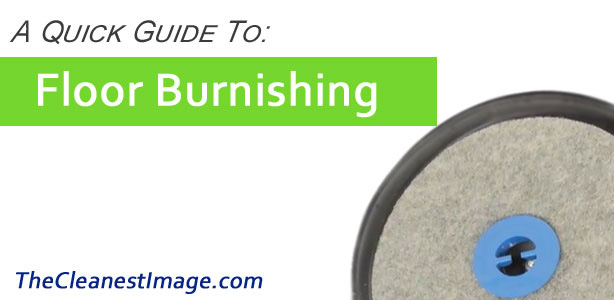The best way to maintain floor finish is high-speed burnishing. Burnishing floors is done with a rotary machine that has a pad speed of more than 1000 rpm but more commonly done at 1500 to 2000 rpm. Burnishing floor finish is helpful for two reasons.
First, it makes floor finish shine. This maintenance process improves the gloss.
Second, and more importantly, it makes the floor easier to keep clean. Because it physically smooths out the scratches in the floor, removing areas for dirt to settle. Once dirt gets in the scratches, it is difficult for regular cleaning to remove. Foot traffic grinds this dirt into the finish. Over time, this grinding damages the floor finish and causes the floor to look dull and dirty.
What Color Pad Is Best For Burnishing Floors?
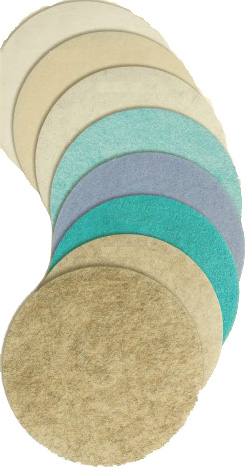
There are many types of pads that can be used for floor burnishing but some of the more common ones are a light tan in color and or have natural fibers incorporated in to the weave of the pads material. These natural fibers are usually hog or horse hair and add more abrasion to the process to aggressively smooth out the floor.
Tan or even white pads can also be used but are typically less aggressive and work more with the thermal properties of floor finish. This means they use friction to heat up the floor finish which melts back smooth.
Regardless of color, make sure you check the manufactures guidelines before using any burnishing pad.
Rules For Burnishing Floors
It is important to know a few universal rules before attempting to burnish floor finish.
Clean The Floor First
With the thermal action that occurs with burnishing, any soils on the floor will be melted into the finish. The only way to remove burnished in soil is to scrub the finish, grinding off finish until it the contaminated layers are gone.
Always Dust Mop Before Burnishing Floors
Dust mopping removes any large particles that can become trapped in the pad and damage the finish or even the floor. Also objects such as rocks, pencils and even hard candy can become a dangerous projectile when flung from the high speeds of a floor burnisher.
Keep The Burnisher Moving
Unlike buffing floors with a low-speed machine, burnishers need to keep moving. Holding the burnisher is one spot will literally burn the floor. There is no reason to do anything but walk at a regular pace when using a burnisher to polish floors. Moving in a simple back and forth motion similar to cutting grass will give you even and effective results.
Change Your Pad Often
Floor burnishing with a clean pad is essential to floor polishing success. When too much dirt accumulates on the pad, it begins to be melted into the floor. It is always a good idea to inspect the pad often. This is to assure there hasn’t been any debris picked up and held in the pad.
Dust Mop After Burnishing Floors
During the process, microscopic floor finish dust particles are sanded away. These will become airborne and can be inhaled. Even if your burnisher has a dust control system, it is always a good idea to vacuum or dust mop after burnishing to prevent dust from being spread throughout the facility.
Floor Burnishing Machines
There are 3 main types of floor burnishers. Each one has its place and setting. They all can have options such as pad pressure settings, dust control, adjustable handles as well as many others depending on make and model. The equipment you use has a big impact on your results of floor burnishing.
The important thing to remember is that the only purpose of a burnisher is to smooth out scratches in floor finish. They are not intended to clean or scrub floors.
3 Common Types of Floor Burnishers
Choosing the right style of cord electric burnisher for your application depends on traffic, finish type, budget and frequency.
Cord Electric Burnishers
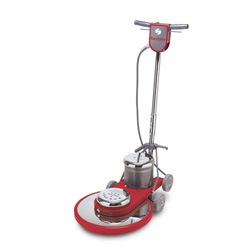
These are powered by an electrical cord plugged into the wall. They are perfect for smaller areas and where noise may be a concern.
Cord Burnishers rely the amount of power it takes to spin the motor and pad, so there are limitations to the length of cord that can be use depending on the electrical system being used, usually 50′ or less. This can become time-consuming and restrictive when outlets are not readily available.
Some units have a variable down pressure while others have a wheel mounted on the front to provide more consistency. Cord electric burnishers also can be either direct drive or belt driven.
Direct drive is where the motor is mounted directly above the pad driver. The motor turns the pad without the need for a belt and pully system.
With belt driven models the motor is offset and connected to the pad driver with a pulley system. There can be some power and torque lost from the belt stretching.
Battery Burnishers
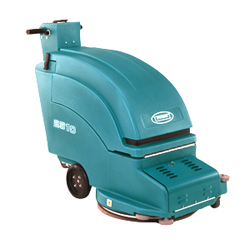
Commonly 1500 to 2000 rpm +, battery burnishers are good choice when noise volume is a concern or if there is not a sufficient power supply for cord electric.
These burnishing machines are very efficient and are easily operated. As with any battery-powered machine, they are limited to the run time and size of the batteries.
The weight of the machine is supported by frame mounted wheels so the pad pressure is independent of the over all weight. Battery floor burnishers are also a great option when noise needs to be kept to a minimum while still cover a large area.
While they still make noise, battery burnishers are much more quiet than a propane burnisher and often have effective dust control options.
Propane Burnishers
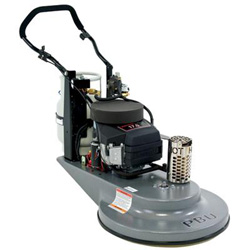
The most powerful of all burnishers, propane burnishers use an engine fueled by propane gas to spin a direct drive pad driver at speeds 2000 rpm and greater.
There are many advantages to propane burnishers, the biggest one being the amount of area that can be covered. Since there is not limitations from cords or battery time, they can keep on going until the job is finished. Modern units have emission controls, safety tanks and a clutch to make them much safer than their early predecessors.
One of the biggest drawbacks is their noise. Although there have been great strides made in noise deadening, the fact is they are still basically running a propane powered lawn mower engine. When brought into a building, the noise prohibits use when there are other activities going on.
That being said, the time they save combined with the results they produce, the use of a propane burnisher can usually be justified.
